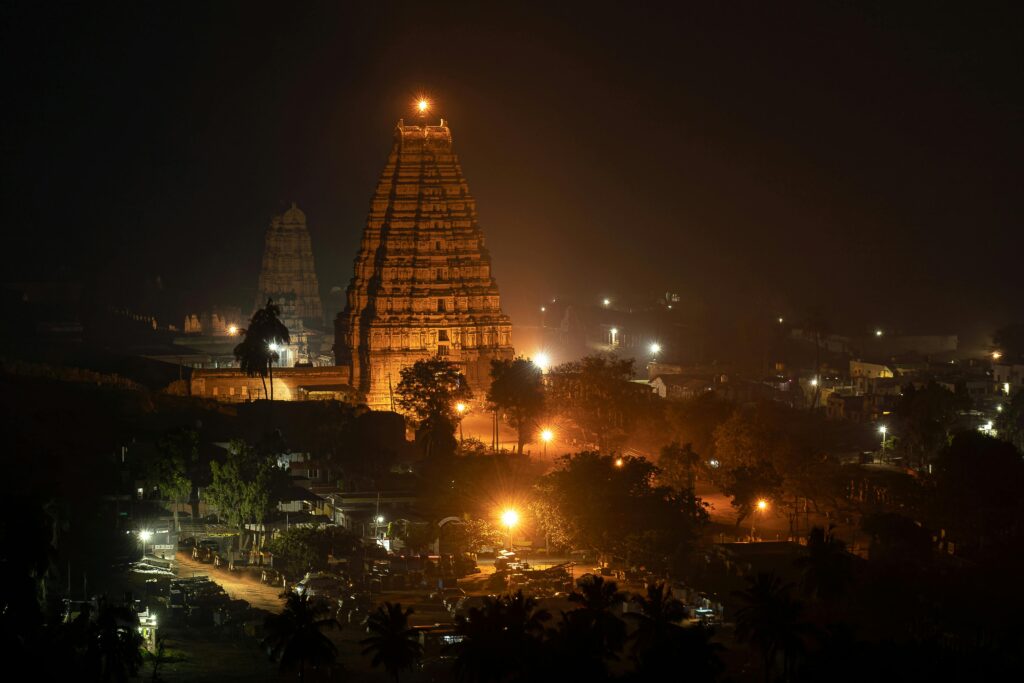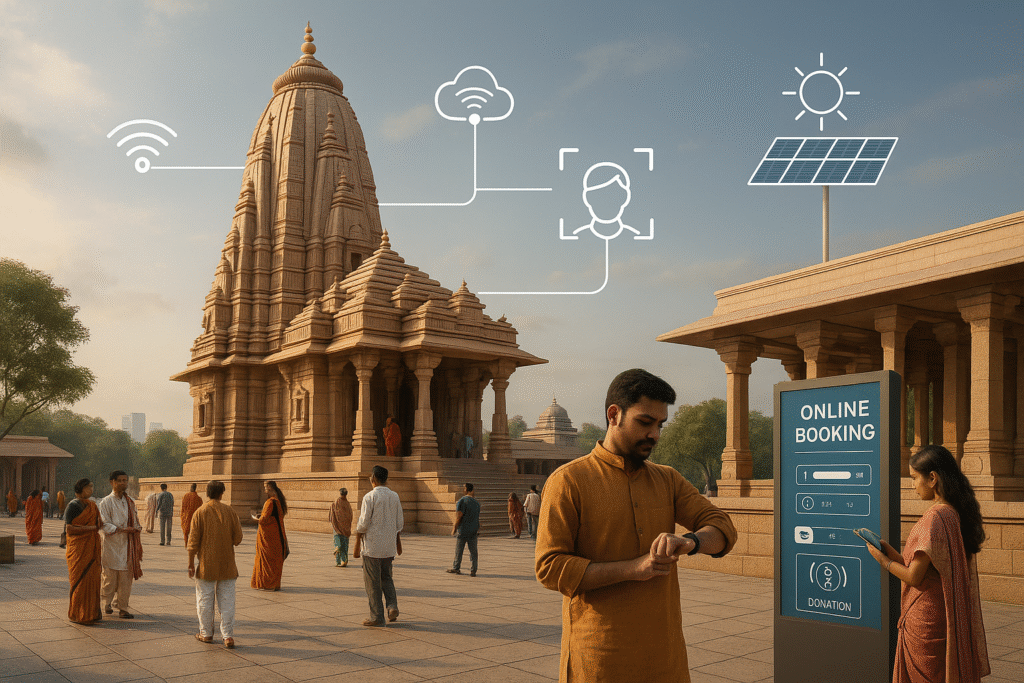
In India, temples are more than places of worship they are cultural anchors, architectural marvels, and community hubs. From the ancient rock-cut caves of Ellora to the vibrant gopurams of Madurai, temples have long embodied innovation. Today, as India embraces its digital and sustainable future, a new trend is emerging: smart temples. By integrating technologies like IoT, AI, and renewable energy, architects are reimagining these sacred spaces to enhance accessibility, manage crowds, and promote sustainability, all while preserving their spiritual sanctity. This blog explores how technology is transforming Indian temple design, showcases pioneering projects, and envisions a harmonious blend of tradition and innovation in 2025.
The Rise of Smart Temples in India

India’s temples attract millions annually Tirupati’s Sri Venkateswara Temple alone sees over 50,000 visitors daily. This scale presents challenges: overcrowding, resource strain, and environmental impact. Post-pandemic, devotees also demand safer, more accessible experiences. Smart temple designs address these issues by leveraging technology to streamline operations and enhance visitor experiences. A 2024 report by the Indian Institute of Architects notes that 60% of new temple projects incorporate smart features, driven by initiatives like Digital India and the Smart Cities Mission.
Key Features of Smart Temple Design
- IoT for Crowd Management
Internet of Things (IoT) systems use sensors and cameras to monitor crowd density in real-time. The Kashi Vishwanath Temple in Varanasi, revamped in 2023, employs IoT to regulate entry, reducing wait times by 40% and ensuring safer darshan during peak festivals like Maha Shivaratri. - Touchless and Digital Interfaces
To minimize health risks, temples are adopting touchless technologies. QR-code-based ticketing and digital donation platforms, like those at Shirdi Sai Baba Temple, allow devotees to book slots or contribute seamlessly via UPI, enhancing convenience and transparency. - Sustainable Energy Solutions
Solar panels and rainwater harvesting are making temples eco-friendly. The Jagannath Temple in Puri installed a 500-kW solar plant in 2024, powering its lighting and cooling systems while reducing its carbon footprint by 20%. - AI-Driven Visitor Experience
Artificial Intelligence enhances accessibility through multilingual audio guides and virtual tours. The Akshardham Temple in Delhi uses AI-powered apps to offer guided tours in 10 regional languages, catering to India’s diverse devotees and global tourists. - Smart Lighting and Acoustics
Adaptive lighting and sound systems create immersive spiritual experiences. The Meenakshi Temple in Madurai introduced sensor-based LED lighting that adjusts to rituals, preserving the sanctity of evening aartis while saving 30% on energy costs. - Climate-Responsive Architecture
Smart temples incorporate passive cooling and ventilation to combat India’s heat. The ISKCON Temple in Bengaluru uses AI-optimized skylights and cross-ventilation, reducing reliance on air conditioning in its prayer halls.
Indian Smart Temple Projects Leading the Way
- Tirumala Tirupati Devasthanams (TTD), Andhra Pradesh
Tirupati’s Sri Venkateswara Temple, one of India’s busiest, is a pioneer in smart design. Its 2024 upgrade included IoT crowd analytics, solar-powered facilities, and a mobile app for real-time queue updates. The temple’s waste-to-energy plant converts floral offerings into biogas, aligning spirituality with sustainability. - Somnath Temple, Gujarat
Revitalized in 2023, the Somnath Temple integrates touchless donation kiosks and AI-driven virtual tours for global devotees. Its seawater desalination system, powered by solar energy, supports local communities, embodying the temple’s ethos of service. - Sri Padmanabhaswamy Temple, Kerala
This historic temple adopted smart security in 2025, using AI facial recognition to enhance safety without disrupting rituals. Its restored gopuram features sensor-based lighting that highlights intricate carvings during festivals, blending heritage with modernity. - Ramanathaswamy Temple, Rameswaram
Facing coastal erosion, this temple introduced climate-resilient designs in 2024, including elevated pathways and mangrove buffers. IoT sensors monitor structural health, preserving the 12th-century architecture against rising sea levels.
Challenges in Building Smart Temples

Integrating technology into sacred spaces isn’t without hurdles. High costs of IoT and AI systems strain temple budgets, especially for smaller shrines. A 2024 survey by the Temple Architecture Forum found that 70% of rural temples lack funds for smart upgrades. Maintenance of tech infrastructure in humid or dusty climates, like those in Tamil Nadu or Rajasthan, is another concern.
Cultural sensitivity is paramount. Devotees may resist technologies perceived as intrusive, as seen in initial opposition to cameras at the Vaishno Devi Temple. Architects must ensure designs respect rituals and privacy, using discreet installations. Additionally, digital divides 30% of rural India lacks smartphone access limit the reach of app-based features.
The Future of Smart Temples in India

By 2030, smart temples could redefine spiritual architecture in India. AI will personalize devotee experiences, such as tailored prayer schedules or virtual pujas for diaspora communities. Blockchain-based donation systems, piloted at the Siddhivinayak Temple in Mumbai, promise greater transparency. Green technologies, like vertical gardens and bio-concrete, will make temples models of urban sustainability, supporting India’s net-zero goals.
Rural temples will benefit from low-cost solutions. For example, Tamil Nadu’s 2025 “Smart Village Temple” initiative equips local shrines with solar lighting and digital booking systems, enhancing accessibility. Training programs, like those by SPA Delhi, are equipping architects to balance technology with temple aesthetics.
As architect Anupama Kundoo noted in a 2025 webinar, “Smart temples must amplify devotion, not distract from it.” The challenge lies in ensuring technology serves spirituality, not overshadows it.
Tips for Designing India’s Smart Temples
- Prioritize Discreet Technology: Embed sensors and cameras subtly to maintain the temple’s sacred ambiance.
- Engage Devotees: Involve temple trusts and communities in planning to align designs with spiritual values.
- Adopt Scalable Solutions: Use modular solar kits or open-source apps to make smart features affordable for smaller temples.
- Focus on Sustainability: Integrate local materials and green systems to reduce costs and environmental impact.
- Bridge the Digital Divide: Offer offline alternatives, like SMS-based bookings, for devotees without smartphones.
Conclusion
Smart temples represent a bold fusion of India’s spiritual heritage and technological future. From Tirupati’s solar-powered facilities to Somnath’s virtual tours, these sacred spaces are becoming safer, greener, and more inclusive. While challenges like cost and cultural sensitivity remain, the potential to enhance devotion and community impact is immense. As India strides toward a digital and sustainable 2030, smart temples will stand as beacons of innovation, proving that technology can deepen, not diminish, the divine. Let’s design temples that inspire awe in both heart and mind.

